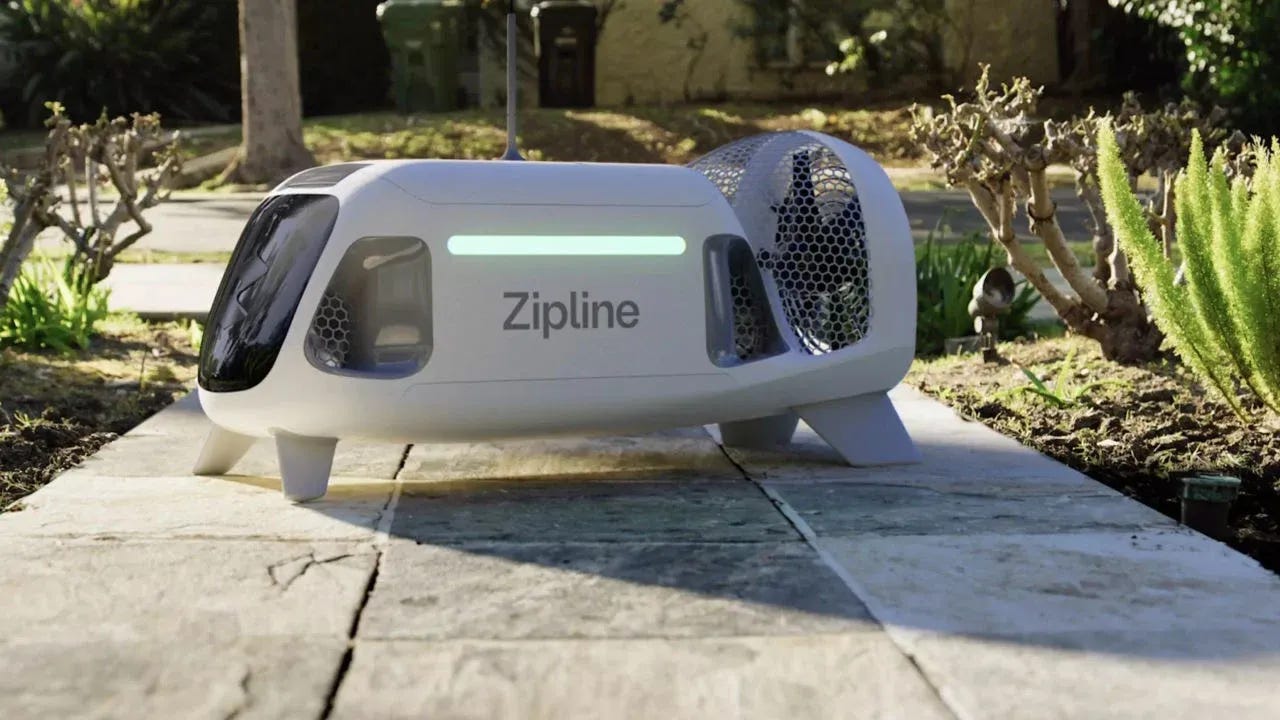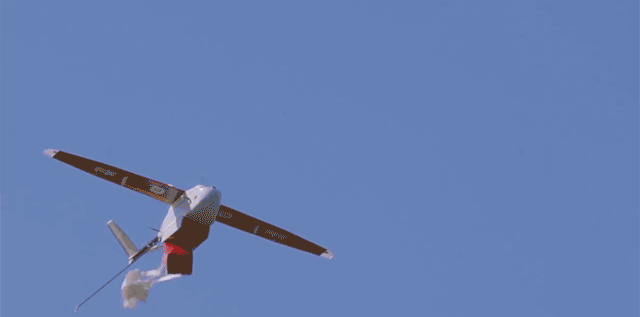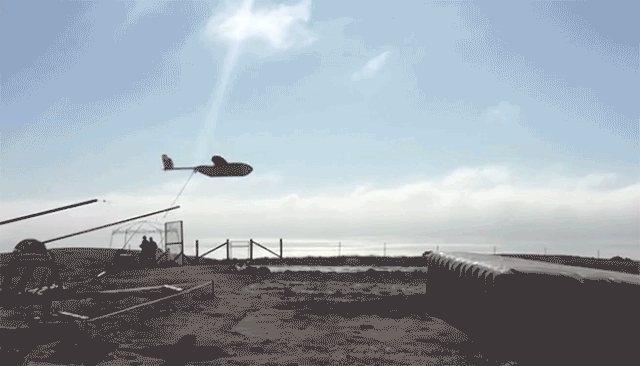I’m joining Zipline: On a Mission to Transform Emergency Healthcare
This week I have some exciting personal news to share. I’ve made the decision to join the team at Zipline, a technology company that provides automated, on-demand delivery of critical goods like medicines, vaccines and blood across the United States, Rwanda, and Ghana through an instant logistics system powered by high-speed autonomous aircraft.
My personal journey with Zipline started in 2016 when I first read that a startup with plans to revolutionise healthcare in Africa had raised an $18 million Series A investment round co-led by the prolific Silicon Valley venture firm, Sequoia Capital, and that Alfred Lin had joined the Zipline board of directors, no less. It piqued my curiosity that a company operating exclusively in Rwanda, a country of 12 million people, could attract investment from a top tier venture firm.
Two years later in 2018, I had the good fortune of meeting Israel Bimpe at the airport in Addis Ababa, Ethiopia during a long layover on my way to Ghana. At the time, Israel was the Head of National Implementation for Zipline in Rwanda, and I had just begun on my own startup journey building Hatch in Sydney, Australia. Luckily, Israel was wearing an unmistakable Zipline t-shirt and was open to grabbing breakfast with me, as we both had a few hours to pass until our next flight. Over breakfast, Israel explained the progress that Zipline had made in Rwanda and that the team was mid-way through construction of their first distribution centre in Omenako, Ghana.
Fast-forward to November 2021: after 4 years of helping to build and scale Hatch to several million in revenue, I made the decision to apply for a role with Zipline launching new international markets.
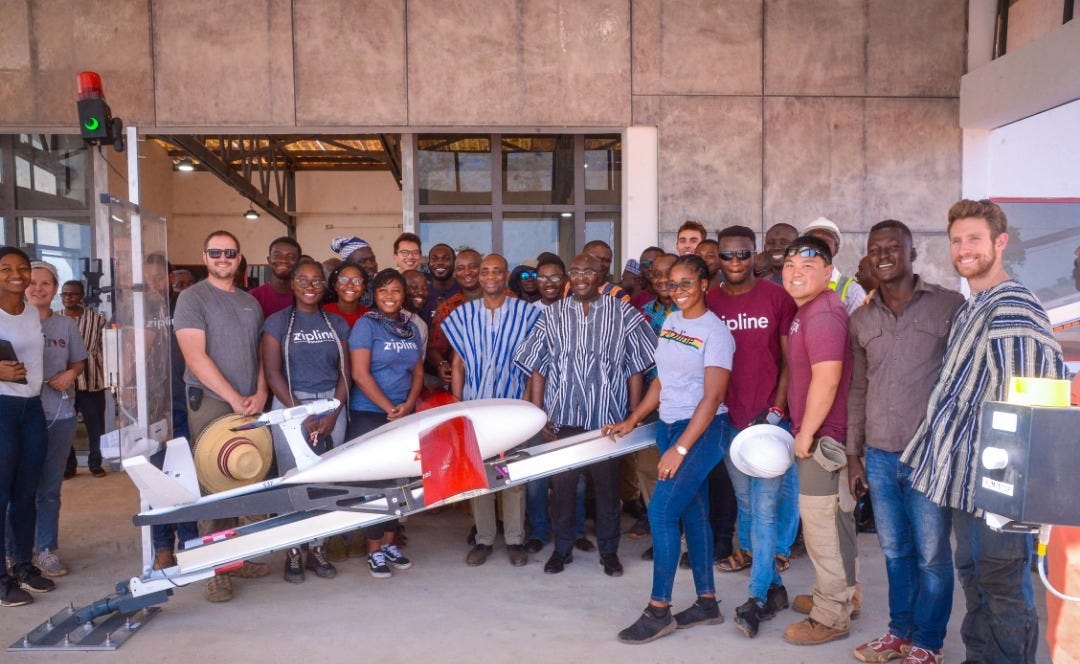
The problem: unpredictable demand in emergency healthcare
Emergency healthcare outside of urban centres suffers from a fundamental trade-off between access and waste. To ensure that hospitals can respond to unpredictable demand, healthcare systems tend to over-stock emergency products at the last mile and simply accept that some proportion of products will expire and have to be thrown out. This is particularly true for emergency blood transfusions: hospitals must stock eight blood groups (A, B, AB and O, in addition to negative and positive rhesus factors) and multiple blood components (red blood cells, plasma, platelets, and cryoprecipitate). In addition, blood products require careful temperature controlled storage, and some products have a very short shelf-life (for instance, platelets expire within one week of collection from a donor).
The problem of blood product wastage is felt most acutely in developing countries, where blood donations are inadequate and health infrastructure is lacking. For example, in June 2021 the WHO Regional Director for Africa, Matshidiso Moeti, commented that Nigeria had a 72% shortfall in available blood product stock, and blood unit wastage rates in public hospitals can be as high as 30%. Taking a second example from South America, in this comprehensive study from Georgetown Public Hospital Cooperation in the Republic of Guyana, researchers found that 25.4% of blood units were discarded over a three year period, largely due to the expiration of products (in 93% of cases). And the cost of blood product wastage is tremendous; for clinics in the eastern region of The Democratic Republic of the Congo, the average cost to collect, test and store a unit of blood is $107 — given that the Congo collects ~250,000 units of blood per year, assuming a conservative wastage rate of 15%, this equates to $3.75 million USD of discarded product every year.
Looking beyond the significant cost of discarded blood products, this problem also directly contributes to a meaningful proportion of preventable deaths. Blood loss following child birth (postpartum haemorrhage) is a leading cause of death for women across the developing world, and in Sub-Saharan Africa roughly one quarter of these deaths are the result of insufficient supply of blood products.
Finally, this problem is not limited to the developing world. For example, in the United States it is estimated that blood wastage rates vary from 1% to 5% in hospitals across the country, which equates to between 200,000 to 1 million discarded blood units each year.
How Zipline improves access to emergency healthcare and reduces waste
Zipline solves the trade-off between access and waste in emergency healthcare by centralising the storage of scarce medical products in world-class distribution centres, where products are easy to keep cool and easy to keep track of. Medical staff at regional hospitals place orders with Zipline through an online portal, WhatsApp or SMS when there is an immediate need (for example, a patient requiring an emergency blood transfusion), and Zipline delivers these products on-demand through a network of high-speed autonomous drones. Deliveries typically arrive within a 30 minute window from when the order is placed, and each Zipline distribution centre services hundreds of locations within an 80km radius.
The core insight is that if you can deliver emergency products very quickly and reliably, you eliminate dependence on expensive refrigeration and high stock counts at the last mile. Instead, scarce products are delivered fast enough via drone that the level of patient care is not compromised, even though the necessary product was not stocked directly at a regional hospital. This is a fundamental transformation of the existing cold-chain logistics network.
Market traction: 225,000 deliveries completed and counting…
Ultimately, building break-through technology will only get you so far; the products that win are the products that touch the lives of the most people, and this is where Zipline’s progress is undeniable.
To date, Zipline has completed 225,000+ commercial deliveries predominantly in Ghana and Rwanda, containing more than 5 million units of vaccines, blood and other emergency medical products. In Rwanda, Zipline currently delivers ~75% of the national blood supply outside of Kigali, the capital city. The blood wastage rate in Rwanda has decreased from an average of 7% prior to the introduction of Zipline, to less than 1% today in participating hospitals.
This progress is the result of incredibly strong local operations, sales and customer success functions in every region that we service. The below graph shared by Zipline’s SVP of US Sales & Customer Success, Irene Scher, illustrates our growth trajectory heading into December 2020, which has only accelerated since.
Doubling down on growth in 2021, Zipline signed agreements to expand services to Nigeria and Côte d'Ivoire. Nine new distribution centres (five in Nigeria and four in Côte d'Ivoire) will collectively service over 10 million people and 3,000+ remote hospitals and clinics.
Our progress is far from limited to the African continent; governments around the world are beginning to recognise the value of Zipline’s emergency logistics system. In the United States, the Federal Aviation Administration granted Zipline an emergency waiver in May 2020 allowing for medical supply deliveries in North Carolina, and Zipline recently entered into partnership with Walmart to begin pharmaceutical deliveries in Arkansas. In Japan, Zipline has announced a partnership with Toyota Tsusho Corporation to begin medical deliveries to remote communities across the country.
Solving difficult engineering challenges is a sustainable competitive advantage
To scale to 225,000+ completed commercial deliveries, Zipline has already had to overcome engineering and operational challenges that most believed were insurmountable. The below quote from an interview with Zipline CEO, Keller Rinaudo, sums up the technical difficulty of our vision.
“The overwhelming advice we got was, this is not technologically possible. Even if it were technologically possible, it wouldn’t work reliably. Even if it did work reliably, there’s no willingness to pay for it and no need for it in different parts of the world. Even if there were a need for it, the technology won’t be able to operate at scale. Over the course of the last three years, every year, we’ve had to disprove one of those notions.”
— Keller Rinaudo, CEO of Zipline
So, how did Zipline create the world’s first drone based healthcare logistics system at scale, and why will it be difficult for other organisations to replicate?
Two factors that have contributed to Zipline’s success in solving tough technical challenges are vertical integration, and an obsessive culture of testing systems to the point of failure.
Regarding vertical integration, Zipline designs and manufactures their own drones, in addition to building and operating their own distribution centres. This is critical because building the entire system from the ground up allows the team to make very quick iterations when things don’t work as expected, and continuously improve every aspect of the system over time, without relying on slow and expensive external contractors.
The technical architecture that underpins this system is unique and has taken almost a decade of iterations to develop. This includes the circuit boards and microprocessors that determine every decision that the drones make mid-flight; the navigation system and air traffic control algorithms that allow the drone to understand the optimal flight route; and the distribution centre’s ultra-capacitor-powered launch catapult and landing system.
Regarding our obsessive culture of testing, Zipline has two fully operational distribution centres in Davis, California and Hatton, North Dakota used exclusively for test flights. This is a critical aspect of Zipline’s product development strategy: engineering teams can design, manufacture and test a new component in a live flight all on the same day. North Dakota was specifically chosen as a test site because it experiences some of the highest wind speeds and coldest temperatures in the United States, pushing Zipline drones to the absolute limit.
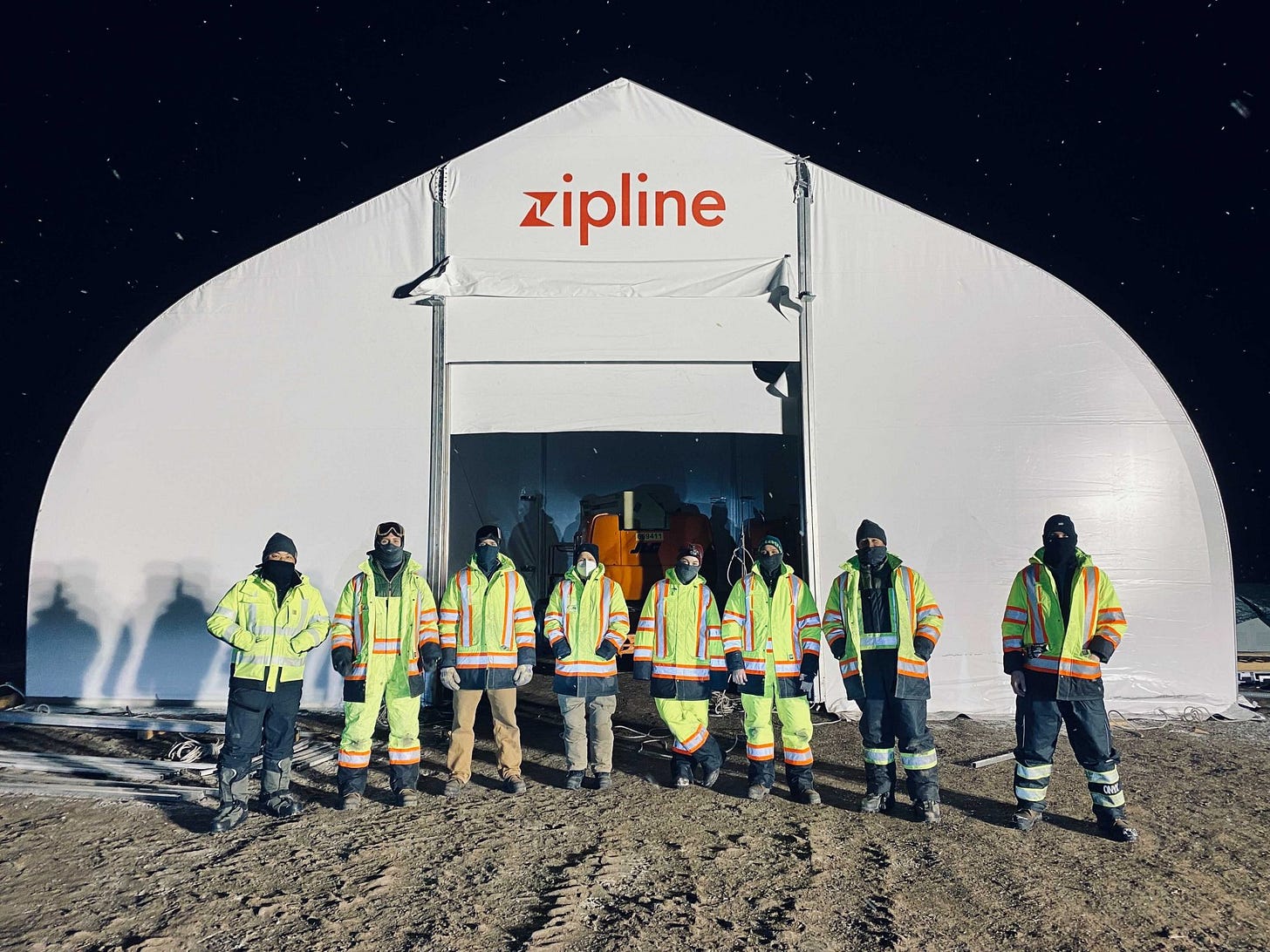
There is no better illustration of the technical sophistication of Zipline’s product than its one-of-a-kind landing system. Zipline drones do not have a landing gear and distribution centres do not have runways, and so decelerating the drone from 113km per hour to a gentle landing was a very challenging problem. The team solved this problem by building a world-first elevated arresting gear — a cable suspended by two 10 metre poles with rotating arms. The cable rotates upwards to catch returning aircraft by a hook on their tail-piece and bring them to a cushioned landing. Below is a video of the first-generation arresting gear in action.
Of course, solving some of the world’s most difficult engineering challenges requires an incredibly talented team. Over the last decade, Zipline has been able to assemble some of the greatest minds in aerospace, embedded systems, robotics, and avionics, including a number of early team members from SpaceX and Tesla. For instance, we recently hired Joseph Mardall, a 10 year Tesla veteran who led the development of the Tesla Model Y heat pump system. Notably, Zipline’s Chief Technology Officer, Keenan Wyrobek, was an early robotics pioneer, co-creating Willow Garage and the Robot Operating System (ROS), an open source collection of software frameworks that underpins much of modern robotics.
Emergency healthcare is just the beginning for Zipline
While the core of Zipline’s mission is ubiquitous access to emergency healthcare, the long-term vision is far more ambitious. Our unique logistics infrastructure could potentially be applied to many industries from general medical supplies, to e-commerce, and farm-produced crops.
Zipline is building a platform for instant deliveries for the entire planet. Rather than prioritising fast delivery of hamburgers and fries, we’ve begun by prioritising life-saving medicine. I’m looking forward to the journey ahead!
References and further reading
Amy Cassidy, Why are women still dying from obstetric hemorrhage? A narrative review of perspectives from high and low resource settings (2020) International Journal of Obstetric Anesthesia (read more)
Imelda Bates, Maternal mortality in sub-Saharan Africa: the contribution of ineffective blood transfusion services (2008) British Journal of Obstetrics and Gynaecology (read more)
Krista Kapralos, A Blood Transfusion in Africa? It’s Free in Rwanda, Unaffordable in Zimbabwe (2017) Global Press Journal (read more)
Rajini Kurup, A study on blood product usage and wastage at the public hospital, Guyana (2016) National Center for Biotechnology Information (read more)
Daniel Marfo, Flexible Supply Chains in Times of COVID: Ghana's Overnight Pivot (2020) (read more)
Jessica Mathews, Walmart is getting closer to delivering cough drops 50 miles away by drone (2021) Fortune Magazine (read more)
Evan Ackerman, Wizards of ROS: Willow Garage and the Making of the Robot Operating System (2017) IEEE Spectrum (read more)
Ann Bailey, North Dakota's nasty winter weather is ideal for California drone company's testing (2021) Grand Forks Herald (read more)
Alice Lloyd George, Sitting down with Zipline CEO, Keller Rinaudo (2017) TechCrunch (read more)
Tom Banks, The designer who built a drone to save lives: an interview with Keenan Wyrobek (2019) Design Week (read more)
Timothy Hannon, Waste Not, Want Not (2015) American Journal of Clinical Pathology (read more)
Jeff Maotela Kabinda, Blood transfusion in the Democratic Republic of Congo: efforts and challenges (2015) Médecine et Santé Tropicales (read more)
Zipline’s Nick Hu on the future of healthcare supply chains (2021) Digital Health Forward (listen)
Keenan Wyrobek discusses how Zipline's AI-drones are reshaping Africa (2021) The Robot Brains Podcast (listen)
Zipline turns five: a look back, and ahead (2021) Zipline blog (read more)
Miriam McNabb, Zipline in Japan: New Partnership with Toyota Tsusho Will Provide National-Scale Drone Delivery Service (2021) Drone life (read more)


